Trust Agreement
Curators: Jacopo Crivelli e Olivia Ardui
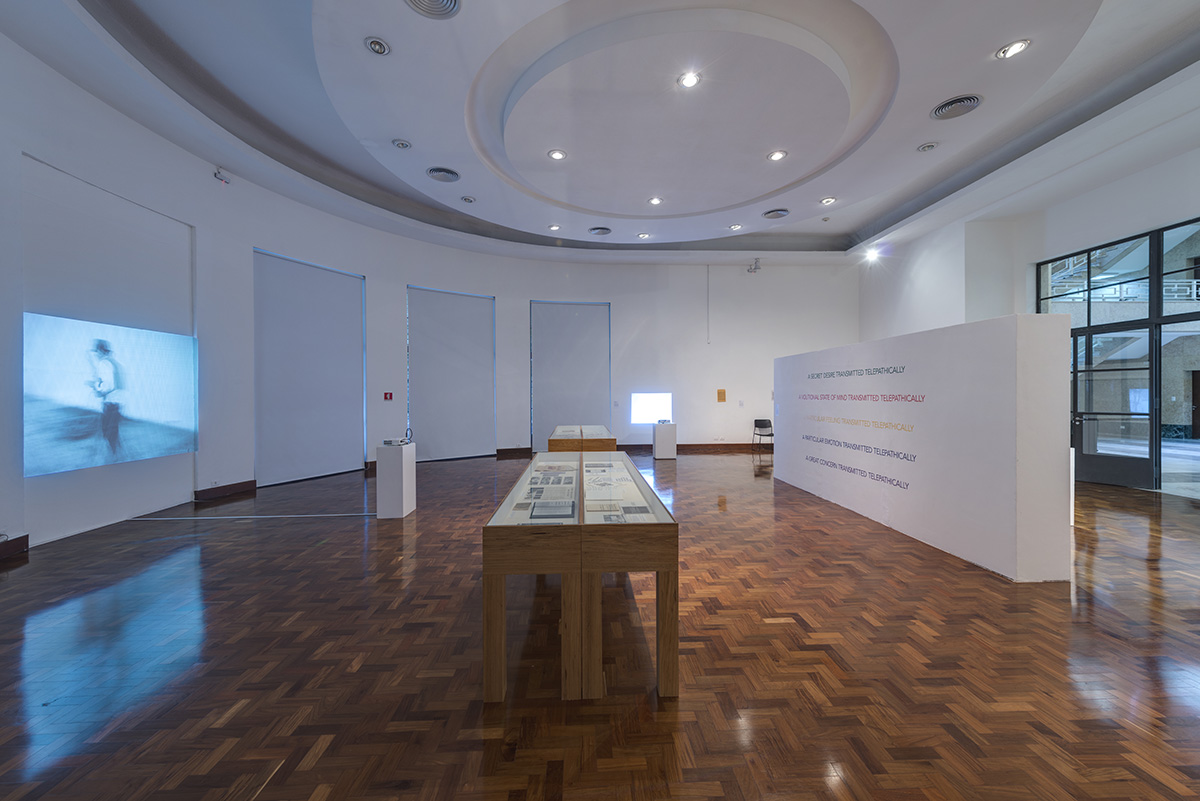

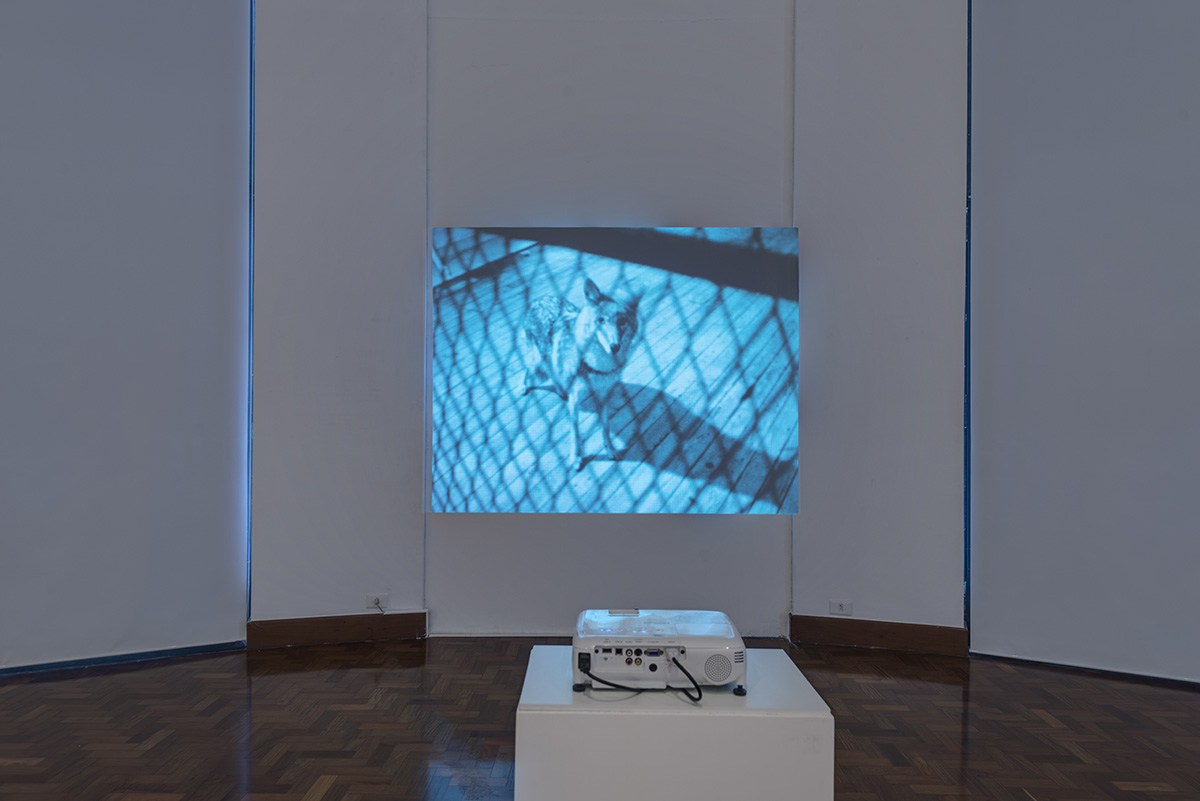


Who are the parties involved in the agreements that regulate an exhibition (among them, the visiting public, artists, curators, collectors, the institution, sponsors...)? How much say do each of them have in the negotiation that leads to the decision of what is shown and how it is shown? What and how many are the contracts, pacts or agreements established between these parties?
Considering that we all belong to at least one of these parties, what role does each of us play in this power game? From the concept of "agreement" — which, in some cases becomes a "contract," with its clauses and obligations, and in other cases, becomes an implicit and informal “pact” — the exhibition is configured as an invitation to reflect on power games and conflicts of interest, which have always regulated society (and not just in Brazil) and, more specifically, the art system. In this sense, it is significant that appropriation, replication, simulation, or parody of the modus operandi of the contract is at the heart of a very significant portion of contemporary production, especially that which belongs to the lineage of American conceptual art and conceptualism from other parts of the world.
More than focusing on iconography, however, the exhibition seeks to reflect on the metonymic and metaphorical implications of the idea of agreement. In other words, the works gathered here are expected to function [metonymically] as the tip of an iceberg, which always indicates the existence of something bigger, submerged, and invisible; and let them be understood [metaphorically] as instruments that point beyond the specific agreement that they themselves regulate, to the importance of pacts, tacit or explicit, in social, political, and institutional settings. Furthermore, these works highlight the need for mutual trust between parties, which should constitute the foundation of any relationship, as well as the recurrent breaches of this trust to the detriment of minorities and dissenters.
The reflection on the norms that should guide exhibitions that take place in an institutional setting was central in the conception of the show. As it is in one of the most visited cultural institutions in the city, the Mário de Andrade Library, it is, evidently, in a place where reflection on the value of what is "public" becomes even more relevant. Most of the works included in the exhibition come from private collections, which, on the one hand, makes it more unique, as they are often inaccessible to the general public, and on the other, seeks to stimulate discussion, although still incipient, about the valorization of work when it is validated by an institutional circuit and the norms of conduct that should regulate this validation. The Trustworthy Agreement project was born out of contacts between Charles Cosac and Pedro Barbosa, with the objective of devising an exhibition of publications, posters, and other materials by artists from the moraes-barbosa collection (belonging to Barbosa and his wife, Patricia Moraes) and from the Mário de Andrade Library, which is directed by Cosac.
Little by little, the show became, on the one hand, more conventional, as it included works from the same collection, from other collectors, and from international institutions, in addition to archival material from the Library itself; and on the other hand, more clearly thematic by focusing on the implications of the concept of agreement, which has become an instrument to invite a transversal reflection in relation to the works and which transcends the artistic scope to touch on institutional, political, and social issues that interest us directly. In addition to maintenance expenses, which are included in the Library's annual budget, the exhibition expenses were covered with private resources and the support of companies, to whom we are grateful. Jacopo Crivelli Visconti, who conceived and curated the exhibition as it can be seen now, has been curator of the moraes-barbosa collection since 2012. Olivia Ardui, co-curator of the exhibition, held an exhibition with works from the collection in 2013.
The context is given. Clarity is the foundation of trust.
Discussion is open.

mark lombardi
[USA, 1951-2000]NuganHand Bank Sydney, Australia,
c. 1974-80, 1995
Graphite on paper
87 x 112 cm
moraes-barbosa collection, São Paulo
In his diagrams, meticulously drawn by hand with pencil or pen on paper, Mark Lombardi highlights the intricate networks of relationships between governments, companies, and personalities from various fields, such as corruption scandals, drug trafficking, or even the war industry.
The artist began by collecting an enormous amount of information about an event, a company, or a person that interested him, but the rhizomes that his works describe seem to dissolve any starting point. This is the case of the work on the NuganHand Bank which, in the Lombardi diagram, is placed in direct or indirect relation to the government of Libya, the Rockefeller family, and even Frank Sinatra and the North American mafia. These “narrative structures,” as the artist himself defined them, bring to light the secret agreements articulated by agents of political, financial, and media power worldwide. In the context of the exhibition, Lombardi's web of relationships works as a metaphor for the agreements, pacts, contracts, and conspiracies gathered here, as well as the multiple relationships that could be identified between the works themselves.

maria loboda
[Poland, 1979]Play of the jewels (10 chalcedonies,
9 amethysts, 10 pumice rocks,
3 pyrites), 2012
10 chalcedonies, 8 amethysts, 10 pumice rocks,
3 pyrites, wooden tray
36 x 36 x 3.5 cm
moraes-barbosa collection, São Paulo
Play of the jewels alludes to the eponymous game, which tests observation and memorization skills. For a limited time, a set of objects of different shapes and materials is displayed to a player. Afterwards, the set is removed and modifications are made to it, which then have to be identified by the player. The game is also known in English as "Kim's game," in reference to Kim, the main character of a novel by Rudyard Kipling where a spy is trained to trust only what he sees with his own eyes. Similarly, the title of the work, which seems to precisely enumerate the set of stones presented, actually does not correspond to what is actually in front of the spectator. Maria Loboda thus questions the trust placed in the facts that are presented to us, highlighting the possible dissonances between a real situation and the discourse associated with it.

andré cadere
[Poland, 1934 – France, 1978]Untitled A00102030 “35” 7 X 9, 1975
Painted wood
41 x 3.5 cm
moraes-barbosa collection, São Paulo
André Cadere created his first wooden stick [barre de bois, in the French original] in 1970, and by the end of his life he produced approximately two hundred of them. The sequence of colors on each stick is unique and organized based on rules of mathematical permutations, in which the artist invariably introduced an error: in this case, following the progression of the first two blocks of three colors, the third should be Yellow-Red-Blue, not Red-Yellow-Blue. The heart of Cadere's work, however, lies not in the sticks themselves, but in how they were used: the artist carried them constantly, exhibiting them in museums and galleries (often in an improvised and clandestine way, without being invited) as well as in restaurants, shops, streets, and other widely visited spaces. In the same way that he introduced an error in the sequence of the sticks, Cadere used his own work as a virus in the rigidly codified system of art.
In this sense, the curators’ decision to exhibit his work with a showcase window responds both to safety criteria and to the desire to instigate a critical reflection on the way in which works that necessitate constant public participation are often exhibited, such as, in the Brazilian context, Lygia Clark’s Bichos or Helio Oiticica’s Parangolés, to cite only known examples.
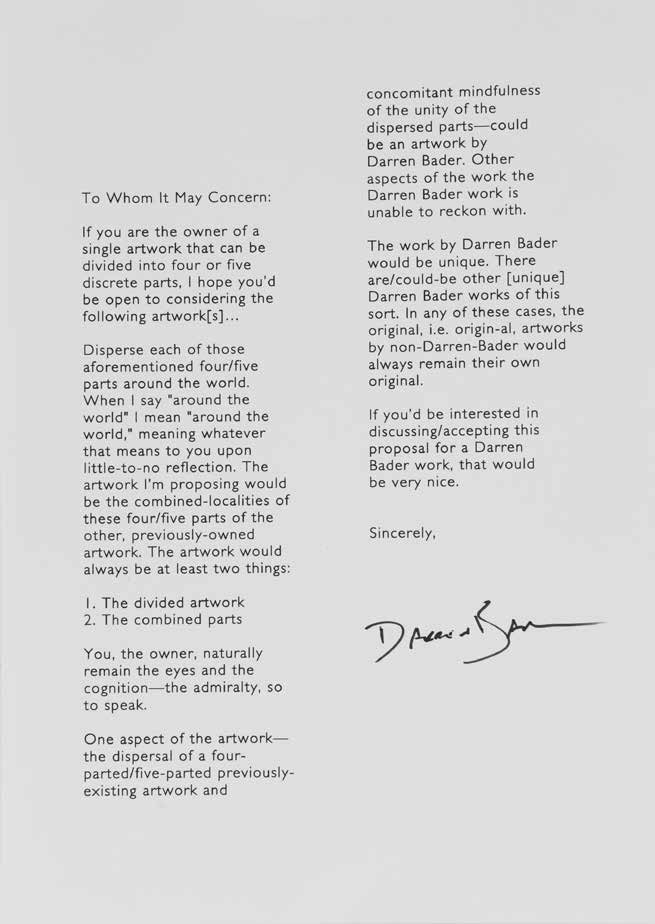
darren bader
[USA, 1978]antipodes: proposal for an art collection, 2017
Ink on paper
Variable dimensions
Courtesy of the artist
All the works in Darren Bader's antipodes series take as their starting point the premise, which is quite present in the contemporary production of conceptual works from the late 1960s, that a work is essentially an idea. According to the artist, a work can exist even if it is divided into several parts, and even if the parts cannot be seen at the same time since they are located in several points of the world. Furthermore, in the specific case of this proposal for an art collection, the work can be both a work by Darren Bader and also an existing work by another artist, which has been distributed to 4, 5, or 6 different places around the world. Beyond the realization, or not, of this proposal, the work exists as an idea, which is why the artist exhibits here certificates that describe it and attest that it was authored by Bader, together with a photo of the first installation in which he put forward the same proposal, albeit in another format.

cameron rowland
[USA, 1988]U66, 2013
Iron with standard finish
167 x 5 x 6 cm
moraes-barbosa collection, São Paulo
Cameron Rowland's work often points to social disparities and the power arrangements that perpetuate them in capitalist society. U66 is a ready-made sculpture, made up of the most used supermarket shelf support in the United States, a choice that exemplifies the artist's concern with capitalist superstructure. Although they look identical, the two pieces present a significant difference: the artist put one up for sale, while the other is just available for rent. Some of Rowland's works, in fact, can be rented for a monthly fee that makes them, in the long run, much more expensive than those sold; this puts the collector (generally a wealthy individual and therefore accustomed to being in a privileged position in negotiations) in the same condition of exploitation to which those less favored are relegated.
Since 1957, the Lozier company has marketed several versions of Gondola, its screwless shelving system. As this model became standard, market dependence led to the emergence of a trade in second-hand Gondola shelving units. Warehouses acquire units from stores that close their activities and resell them to other businesses, which can only afford units at a discount. Like other industrial systems, Gondola is made up of a series of standardized parts. Used parts are rarely sold individually, but they are accounted for as units.
However, if removed from the set, an individual element becomes unrecognizable, as its visual coherence depends on context. The subtraction of a part makes its possibility of constituting a unit unfeasible. Attempts to integrate that which is excluded often involve improving economic conditions. Cora Walker and other local leaders founded the Harlem River Consumers Cooperative Supermarket in 1968 as a way to control their purchasing power. Variations of this model of community economic development have multiplied since then. Often driven by community development movements, this model is reproduced in terms of pre-existing value.

philippe thomas
[France, 1951-1995]readymadesbelongtoeveryone.
32 postcards from Tyne Internationale Kunstverein Hamburg (1993),
7 postcards from Kunstraum München (1992)
(E. Felten, I. Goetz, S. Goetz, W. Lippert, A. Oetker, A. Tacke, J. Zander),
1 postcard from the Claire Burrus Gallery (1993)
10 x 15 cm (each)
Courtesy of the artist and Jan Mot, Brussels/Mexico City
Inspired by artists and thinkers as diverse as Fernando Pessoa and his heteronyms, Marcel Broodthaers and his fictional museums, and, naturally, Marcel Duchamp and his ready-mades, Philippe Thomas founded in 1987 the readymadesbelongtoeveryone agency. All of the agency's works, created by Thomas himself, were for sale, with the particularity that they were considered not only property but, long before that, as being authored by the person who acquired it. Essential in an exhibition that reflects on the relationships between collectors, artists, and all other agents of the art system, Thomas’ work and the readymadesbelongtoeveryone agency is presented here through a sort of retrospective, which includes several of his best-known works reduced to postcard format, once again following a strategy that is close to language and emphasizes publicity codes rather than artistic ones.
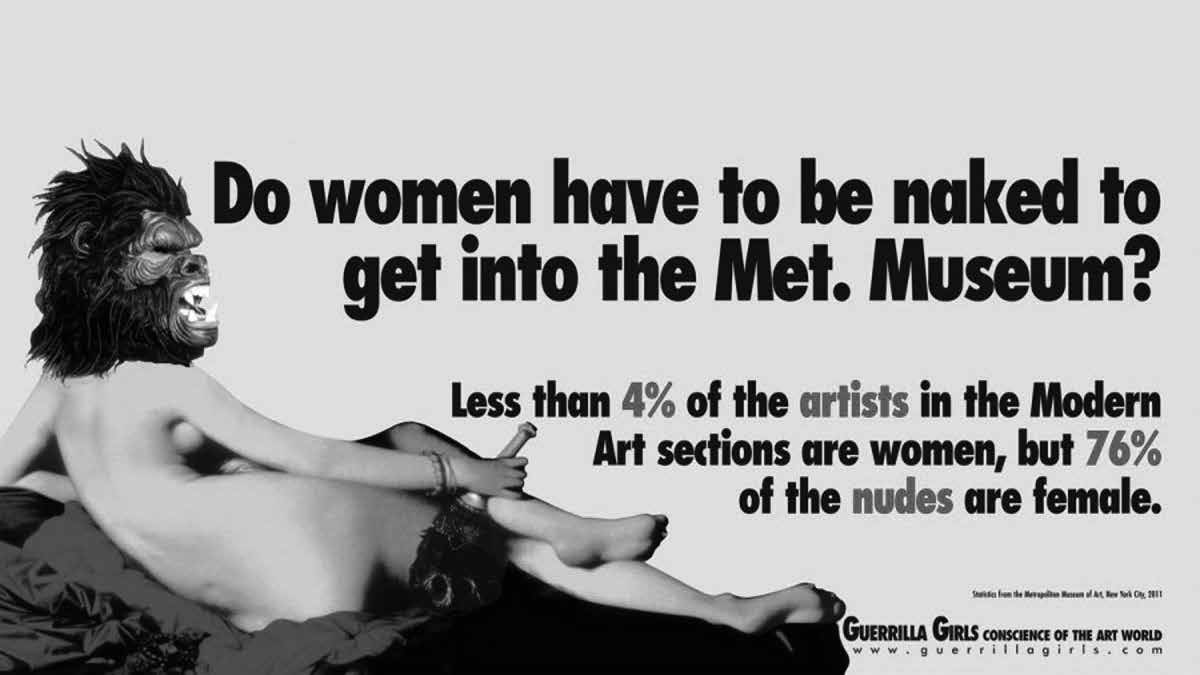
guerrilla girls
[USA, collective formed in 1985]Selection of posters created by the collective, 1985
Mixed media on paper
Varied dimensions
Since 1985, the Guerilla Girls, a group of American activist artists, have developed a series of posters, flyers, and actions that highlight racial and gender inequalities, especially with regard to the art system. To maintain anonymity during their interventions or public appearances (such as lectures, workshops, and exhibitions), the artists wear characteristic gorilla masks and use the pseudonyms of recognized and deceased artists.
Handling advertising language and strategies with humor, they produce graphic materials that expose symptomatic statistics of the low representation of women and non-white artists in publications, exhibitions, museum collections, and private collections, constituting one of the rare examples of humorous "institutional criticism."
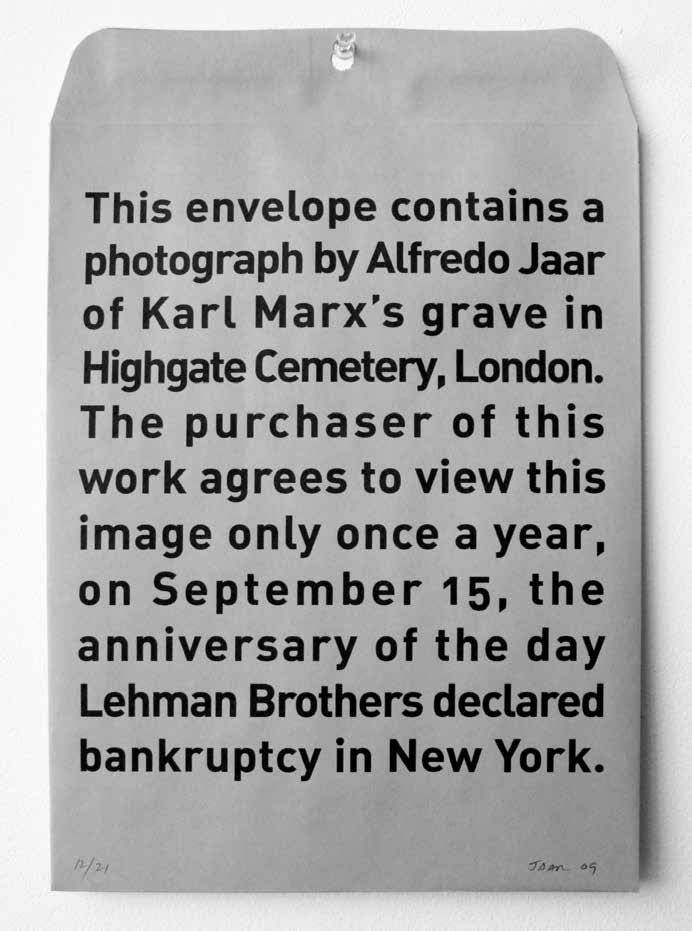
alfredo jaar
[Chile, 1956]September 15, 2009
Inkjet digital printing on manila envelope and photography
Photography: 21.5 x 28 cm
Envelope: 23 x 30.5 cm
Camilla and Eduardo Barella Collection, São Paulo
Alfredo Jaar has addressed in his work the inequalities, injustices, and conflicts, both social and political, of capitalist society. September 15 consists of a photograph of the tomb of Karl Marx, the philosopher and socialist theorist who predicted the crisis of the capitalist model, taken by the artist himself and kept in an envelope.
As spelled out in the text on the envelope, upon acquiring the work, the owner commits to looking at the image only once a year, on September 15th, the anniversary of the collapse of Lehman Brothers. The failure of this US investment bank in 2008, in addition to being one of the biggest bankruptcies in US history, triggered a financial crisis with few precedents. If Marx's analysis can help to understand events such as the failure of a bank, the fact that the image represents his tomb makes the work subtly ambiguous.
![robert barry [Estados Unidos, 1936] 5 Telepathic Pieces, 1969 Vinil recortado sobre parede Dimensões variáveis Cortesia do artista e untilthen, Paris Em 1969, Robert Barry concebeu uma série de trabalhos telepáticos, nos quais se esforçava para transmitir psiquicamente uma determinada mensagem ao público. Nas palavras do artista, “o trabalho é sempre completado por outras pessoas”, isto é, pressupõpe a participação, ou até a cumplicidade, do p.blico em aceitar as premissas da peça. Foram realizados ao todo cinco trabalhos telepáticos, considerados entre as obras mais icônicas da arte conceitual e aqui expostos em sua versão de parede, que deveria constituir o envio de Barry para a 10a Bienal de São Paulo, deste mesmo ano. Trata-se daquela que ficaria conhecida como “Bienal do boicote”, por causa do enorme número de artistas já confirmados que, como o pr.prio Barry, decidiram retirar seus trabalhos da exposição em protesto contra a ação repressiva da ditadura militar, que, em 13 de dezembro de 1968, promulga o Ato Institucional no 5, inaugurando o período mais sombrio da recente história brasileira.](https://freight.cargo.site/t/original/i/1a2895d283e5e81c2ee7876ca8984e79f5d264abdf9255aae1af891ce6a35829/robert-barry.jpg)
robert barry
[USA, 1936]5 Telepathic Pieces, 1969
Cut vinyl on wall
Variable dimensions
Courtesy of the artist and untilthen, Paris
In 1969, Robert Barry conceived of a series of telepathic works, in which he strove to psychically convey a certain message to the public. In the artist’s words, “the work is always completed by other people;” that is, it presupposes the participation, or even the complicity, of the public in accepting the premises of the piece.
A total of five telepathic works were created, which have been considered among the most iconic works of conceptual art. They are exhibited here in their wall version and are what was supposed to constitute Barry's submission to the 10th São Paulo Biennial occurring that same year. This is what would become known as the “Boycott Biennial,” because of the huge number of artists already confirmed who, like Barry himself, decided to withdraw their works from the exhibition in protest against the repressive action of the military dictatorship, which, on December 13, 1968, promulgated Institutional Act number 5, inaugurating the darkest period in recent Brazilian history.

mario garcía torres
[Mexico, 1975]What Happens in Halifax Stays in Halifax (In 36 Slides), 2004-2006
35 mm slides, transformed into digital projection
11' 10''
Courtesy of the artist
In 1969, at the invitation of one of the professors at the Nova Scotia College of Art and Design (NSCAD) in Halifax, Canada, Robert Barry gave instructions for a group of students to create a work of conceptual art. The only condition for the work's existence was that it be kept secret by the students: if they revealed anything about it to anyone outside the group (including Barry himself), it would cease to exist.
In 2004, Mario García Torres began to investigate this proposal and, in particular, the impact of the work on the lives of the people involved. Acting almost like a detective, the artist located and contacted the students, talked to them, and tried to get information about the secret that, apparently, has not yet been revealed.

ian wilson
[South Africa, 1940]There was a discussion with Lawrence Weiner in New York City (walking up
6th Avenue to Kosuth’s place),1968
Typed and signed paper
28 x 21.5 cm
moraes-barbosa collection, São Paulo
In 1968, Ian Wilson stopped producing physical works, organizing his work from that moment on as a sequence of “oral communications,” among which the best-known series is that of the “discussions.” These works consist exclusively of a joint discussion and reflection on philosophical themes, but which also affect the lives of each person; the themes include such topics as “time,” a recurring issue in Wilson's practice. These discussions are not recorded, so they only exist at the time they are held and, later, in the participants' memories. The only remaining trace of these encounters consists of a statement signed by the artist, which succinctly describes the discussion, but without revealing anything about it. In this case, for example, Wilson states only that, "There was a discussion with Lawrence Weiner in New York (walking up 6th Avenue to Kosuth's place).”

isidoro valcárcel medina
[Spain, 1937]Madrid, 1973
Offset printing on kraft paper
33 x 33 cm
Over several decades, Isidoro Valcárcel Medina has been building an extremely rigorous body of work in which art and life frequently fuse to the point of becoming inseparable. Madrid is, at the same time, both a description and a denial of an exhibition: invited to exhibit at the Seiquer gallery in Madrid, Valcárcel Medina chose to “transfer” the space and time that were made available to the public, so that he could carry out any “activity or proposal that he deems opportune to carry out on the fringes of the field of art, or that could belong to art.”

maria eichhorn
[Germany, 1962]5 weeks, 25 days, 175 hours
Documentation about the exhibition
Chisenhale Gallery, London, United Kingdom, 2016
Courtesy of the artist and Chisenhale Gallery
For her exhibition, 5 weeks, 25 days, 175 hours, Maria Eichhorn interrupted the functioning of the Chisenhale gallery, a public exhibition space in London. The day before the opening, a symposium was organized at the site, which had been stripped of art work, bringing together a number of experts to discuss current working conditions.
Then, during the entire period of the show, which lasted from April 24 to May 29, the gallery remained closed. In 1969, Robert Barry carried out, in three different galleries, a work that consisted solely and exclusively of leaving the exhibition space closed; but by carrying out her proposal in a public space, Eichhorn radically transformed the meaning of this gesture. In a silent, yet powerfully subversive way, the artist questioned the capitalist logic regarding the use of time, the efficiency of work, and the search for productivity, all by entrusting the gallery staff with a single task: not working.

seth siegelaub
[USA, 1941 – Switzerland, 2013]Selection of publications
Gallerist, curator, collector and researcher, Seth Siegelaub is recognized for his role in the consolidation and dissemination of conceptual art in the late 1960s. His projects, often conceived and carried out in close collaboration with artists such as Lawrence Weiner, Robert Barry and Douglas Huebler, among others, challenged and questioned the role of each of the agents of the art system, as well as the devices, parameters, and conventional exhibition formats. Siegelaub did not consider the physical presence (or even the existence) of the works to be essential: his exhibitions could take the form of a catalog (as in January 5-31, 1969) or of a book depicting works created in response to an invitation/challenge of the curator (as in the case of the Xerox Book, 1968). He also drafted, together with lawyer Robert Projansky, the first contract that tries to regulate the circulation of works of art after their first sale. The contract constitutes a reference document, in the sense of strengthening the artist, in a defense of his economic and moral rights.
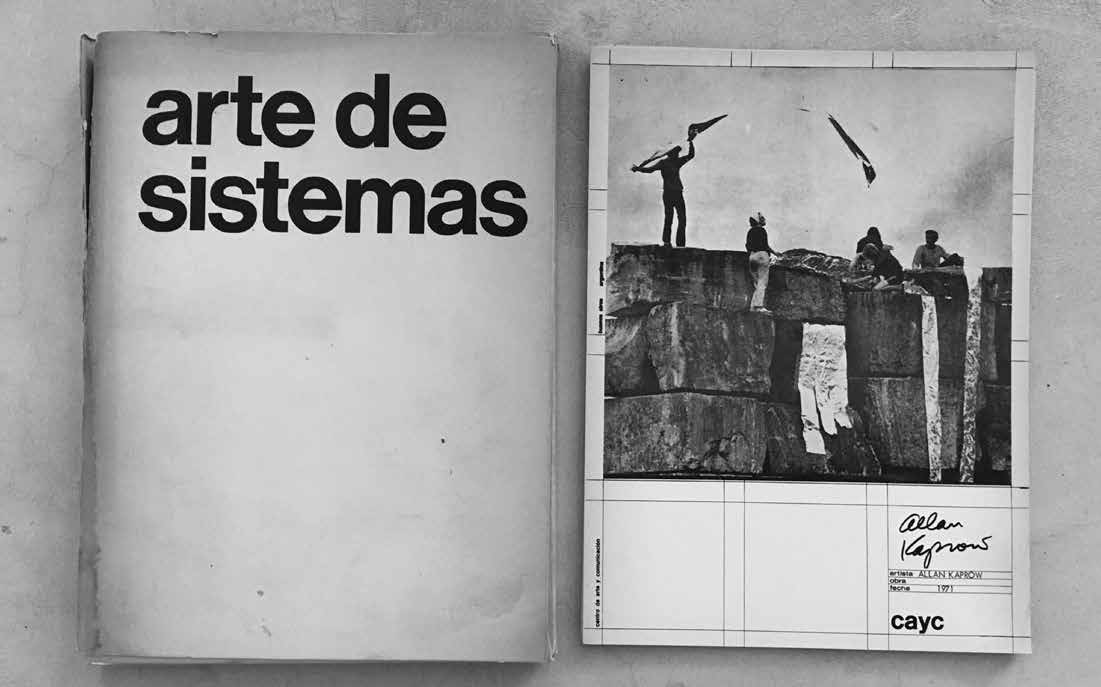
centro de arte y comunicación (cayc)
[Argentina, 1968-2012]Arte de Sistemas, 1971
lucy lippard
[USA, 1937]955.000, 1970
Exhibition catalog
Lucy Lippard is a critic, curator, and theorist and among the first to theorize the dematerialization of the art object in the 1960s. One of her most recognized projects is the Numbers Shows, a set of exhibitions held in different cities, which brought together minimalist and conceptual artists. Dealing with an extremely low budget, Lippard opted for works that were easily transportable or produced on-site — in many cases, simple instructions that she would follow herself to create the work, since in most cases the artists could not be present during the assembly of the exhibit. The title of each of these exhibitions corresponds to the number of inhabitants of the city that received it, and the catalog consists of file cards with the assembly instructions for the works. In 1970, after Seattle and Vancouver, Lucy Lippard held the exhibition 2,972,453 in Buenos Aires at the Art and Communication Center (CAyC). Created in 1968, the center brought together a group of Argentine conceptual artists who gravitated around the theorist Jorge Glusberg. One year after receiving Lippard's exhibition, CAyC organized the Art of Systems exhibition, which used a collaborative strategy similar to that proposed by the American curator.
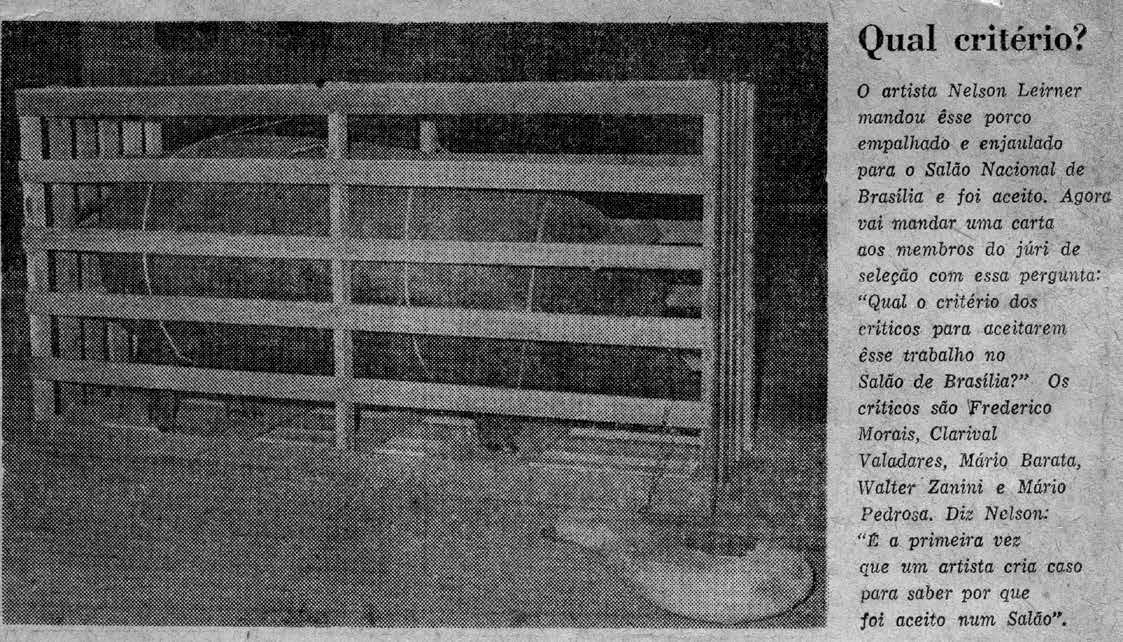
nelson leirner
[Brazil, 1932]Archival material
Courtesy of the artist and the Mário de Andrade Library
Nelson Leirner's works and proposals have always been distinguished by a contestatory irony that questions the status of the work, the functioning of the art system, and, by extension, consumer society as a whole. The artist shared these concerns, among others, with Wesley Duke Lee and Geraldo de Barros, with whom he founded Grupo Rex in 1966.
The motto “Warning: it's the war” opened the editorial of the first issue of the group's periodical, Rex Time, setting the tone for the actions that the group would carry out at Rex Gallery & Sons. This was the case, for example, with the Non-exhibition Exhibition, the gallery's last event, in which Leirner let the public remove the works from the walls and take them free of charge, breaking not only with the conventional codes of an exhibition space, but also with the protocols of buying and selling a work of art. Another of Leirner's most daring proposals became known as a critical happening. After being selected for the IV Modern Art Salon in Brasília in 1967, the artist submitted a stuffed and caged pig, thereby questioning his selection and the members of the jury, who responded to the artist’s provocation with different newspaper articles.
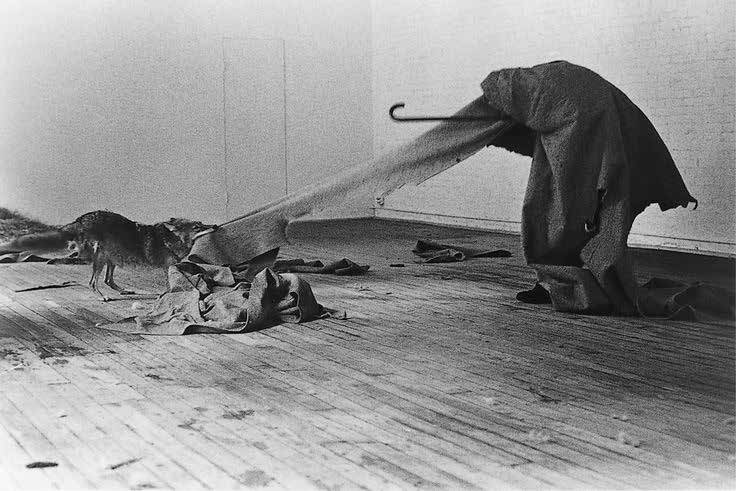
joseph beuys
[Germany, 1921-1986]I like America and America likes me, 1974
Performance video by Joseph Beuys
37' 10''
Helmut Wietz (director)
Courtesy of Common Film Produktion, Berlin, Germany
The video of Joseph Beuys's mythical performance, I Like America and America likes me (1974), is a poetic counterpoint to many of the works gathered in this exhibition. Beuys spent eight hours a day, for three straight days, with a coyote in a makeshift cage at Ren. Block Gallery in New York. The gallery floor, covered with copies of the Wall Street Journal, was the only ground in the United States where the artist set foot: he stayed in the country only for the performance, and on the way to and from the airport, he was taken in an ambulance, wrapped in a felt blanket. In Beuys' shamanic symbology, the coyote represents the virgin nature of America, revered by the natives and almost extinguished by the colonists, whose cult of militarism, which Beuys actively opposed, was manifested in this period in the Vietnam War. And in fact, in addition to the choreography of the artist and the coyote (extremely relevant in an exhibition where the subject is agreements and exchanges), the title places the action in a political context that the subtle irony does not make less controversial.
Transferred to the Latin American context, the phrase I like America and America likes me, which Joseph Beuys had coined for the only work he produced in the United States, becomes ambiguous, especially when read from the perspective of the so-called "Good Neighbor Policy" (1933-1945), which sought to present the United States as a kind of rich, friendly, successful cousin who looked after his southern neighbors. Within the scope of this policy, cultural diplomacy held a privileged place and actively contributed to the circulation of the work of artists such as Alexander Calder, considered exemplary for the diffusion of North American values. In addition to the donation and exhibition of works, an integral part of this policy was the establishment of museums of modern art throughout Latin America, frequently raising the possibility, which would almost never materialize, of exhibitions by Latin artists at MoMA or other North American museums. In 2010, decades later, MoMA itself would refuse the request to loan the paintings from the October 18, 1977 series by Gerhard Richter for the 29th São Paulo Biennial, leading the curators to ask the artist Sandra Gamarra to replicate them as part of the LiMac collection — a fictitious and intensely post-colonialist museum founded by her. The next step in this endless game of power, admiration, and desire for emulation was the appointment of one of the MoMA curators to organize the 30th edition of the Biennial.
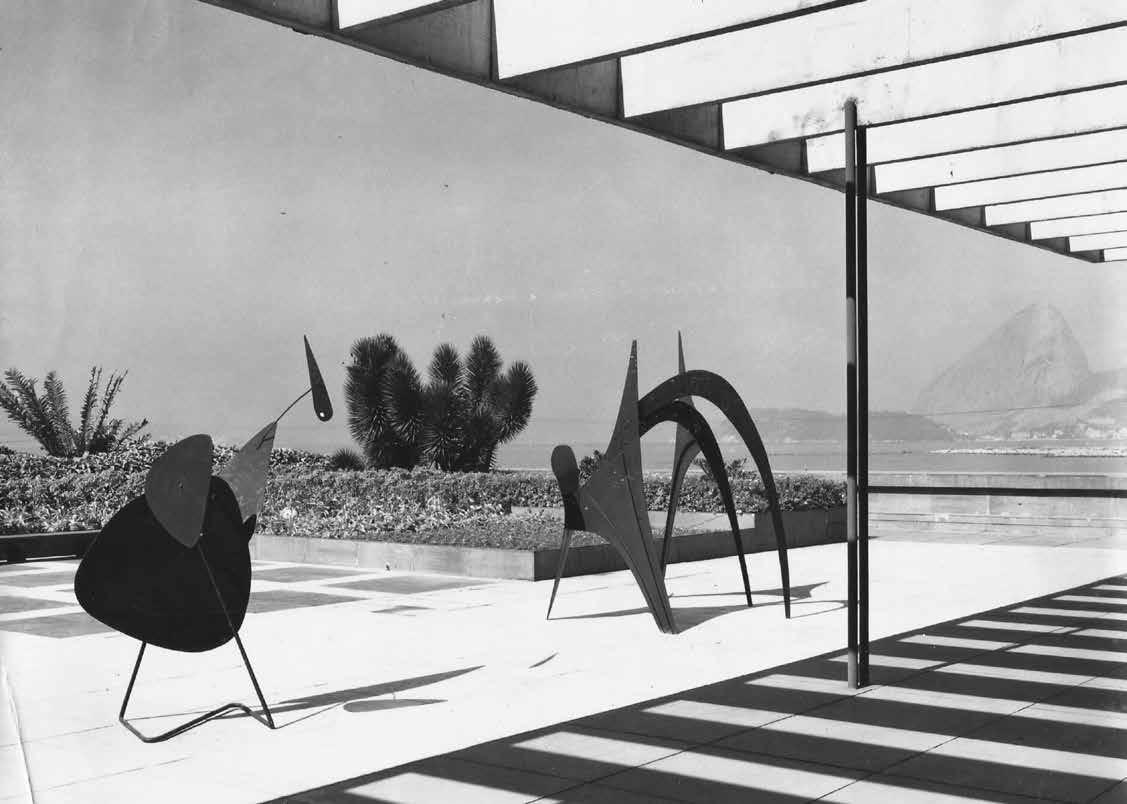
alexander calder
[USA, 1898-1976]Correspondence, publications, photos, and clippings from and about Alexander Calder, produced between 1948 and 1972.
moraes-barbosa collection, São Paulo and courtesy of the Mário de Andrade Library
Already internationally recognized, mainly for his mobile sculptures, Alexander Calder visited Brazil for the first time in 1948 to prepare an exhibition at the then Ministry of Education and Culture in Rio de Janeiro. From that moment on, the American artist would return to the country many times, establishing lasting relationships with several intellectuals, such as the critic Mário Pedrosa and the architect Henrique Mindlin. Among the people with whom Calder developed close friendships are the American writer Mary Morse and her companion Lota de Macedo Soares, an architect and landscaper from Rio de Janeiro who was one of those responsible for the reconfiguration of the Flamengo landfill. In this role, Lota de Macedo Soares would contribute to the acquisition and installation onsite of two of the artist's sculptures, which were later stolen in 1985. Alongside documents, photos, and newspaper clippings, the selected correspondence addresses practical aspects, such as the transport or negotiation of his works, depicting a complex episode that needs to be contextualized beyond the history of Brazilian art and against the backdrop of the North American political strategy of the period in relation to Latin America.
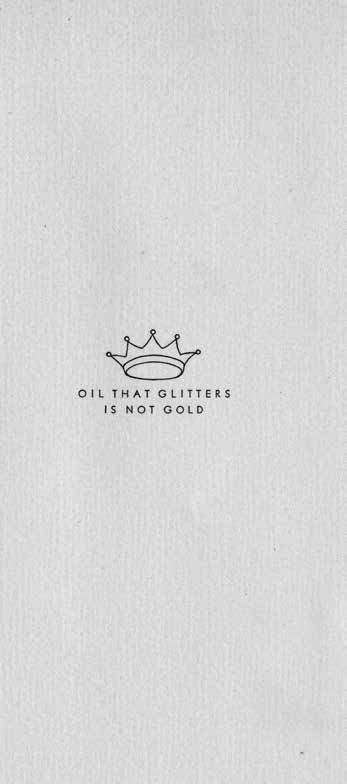
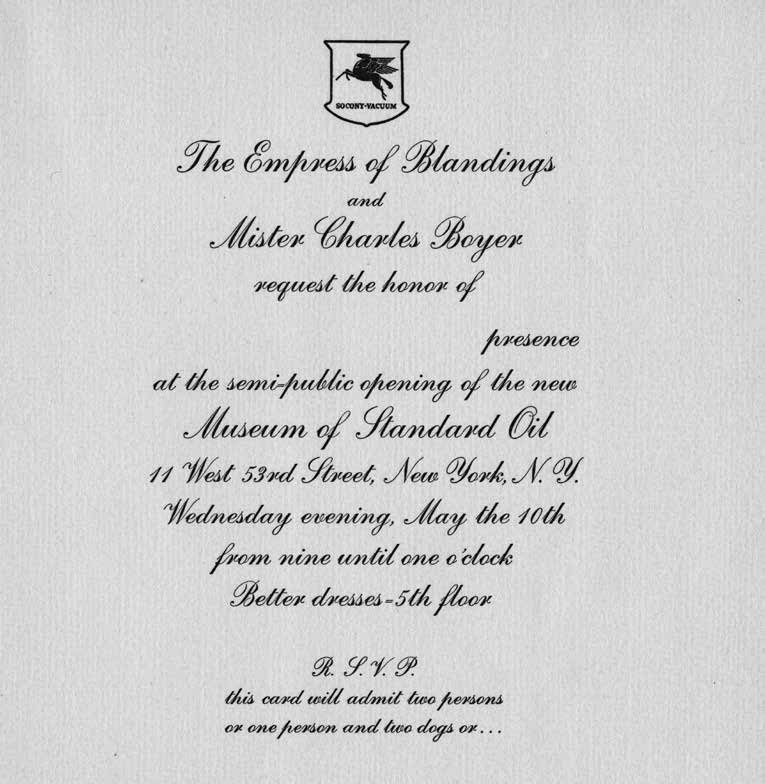
alessandro balteo-yazbeck
[Venezuela, 1972]RSVP, 1939, 2007-09
(part of the Cultural Diplomacy: An Art We Neglect series)
C-print, cover of Time magazine (May 22, 1939), cut vinyl on wall, and plaque with text
90 x 120 cm
Courtesy of the artist
In 1939, Frances Collins, responsible for the publishing sector at MoMA in New York, prepared a fictitious invitation to the opening event of the “new Standard Oil museum” to show how the museum’s activities were guided by economic and political interests — more specifically, those linked to the distribution and exploitation of oil. In the same year, Nelson Rockefeller was elected president of MoMA and promoted a series of exhibitions throughout Latin America that, far beyond their cultural character, were part of the North American strategy of dissemination in the continent known as the “Good Neighbor Policy,” which had been initiated by the government of Franklin D. Roosevelt (1933-45). RSVP, 1939 highlights the economic, strategic, and political interests of cultural diplomacy by juxtaposing the fictional MoMA invitation with statements by some of the main characters of the plot, which find an echo in the exhibition in the correspondence of Alexander Calder, an artist deeply studied by Balteo-Yazbeck precisely because of the role of his work in the cultural strategy of North American cultural expansionism.

hans haacke
[Germany, 1936]Hans Haacke — Works 1970-78
Exhibition poster
Museum of Modern Art, Oxford, United Kingdom, 1978
“The pleasure that art gives me is aesthetic rather than intellectual.
I'm not concerned with what the artist wants to say; it's not an
intellectual operation — it's what I feel.”
— NELSON ROCKEFELLER
I'm not concerned with what the artist wants to say; it's not an
intellectual operation — it's what I feel.”
— NELSON ROCKEFELLER
Hans Haacke is an essential artist in any discussion about norms, agreements, and conspiracies between the various agents of the art system, and especially about the way in which external interests influence the functioning of this system. One of the pioneers of the so-called "institutional criticism," Haacke has been a reference for generations of artists by explaining in both a symbolic and direct way the intricate and often hidden links between art, politics, and finance. In the context of his work and writings, his research on the functioning of great American museums, such as MoMA in New York, is especially relevant. The artist's interest in Nelson Rockefeller arises precisely from the fact that the businessman had been a member of the institution's board for decades and president of it for several terms (1939-1941; 1946-1953). Significantly, the phrase quoted by Haacke seems to describe a type of work absolutely opposite to that of the German artist, in which aesthetic issues can never be separated from an ethical discourse and a reflection on the functioning of society.

sandra gamarra
[Peru, 1972]October P.g. 20b, 2010
Oil on canvas
87 x 102 cm
Courtesy of the artist and Leme Gallery, São Paulo
In 2002, Sandra Gamarra founded LiMac, a fictional museum, or “museum project,” as she defines it, for the city of Lima, which at the time did not have any space for contemporary production. Many of her paintings flow into the museum and often reproduce works by masters of modern and contemporary art as a way of filling the void created by the absence of active cultural institutions in Peru (and Latin America more generally). The painting included here is part of the set that reproduces the famous canvases from the series October 18, 1977 by the German painter Gerhard Richter, which, in turn, replicate images from the press and police records of members of the far-left terrorist group Baader- Meinhof, a group that was active in West Germany from the late 1960s, was arrested in 1972, and then killed in Stammheim Prison in circumstances that were never fully understood.
ARTISTS: Alessandro Balteo-Yazbeck, Alexander Calder, A lfredo Jaar, A ndré Cadere, Cameron Rowland, C entro de Arte y Comunicación (cayc), D arren Bader, G uerrilla Girls, H ans Haacke, I an Wilson, Isidoro Valcárcel Medina, J oseph Beuys, L ucy Lippard, M aria Eichhorn, M aria Loboda, Mario García Torres, M ark Lombardi, N elson Leirner, P hilippe Thomas, R obert Barry, S andra Gamarra, S eth Siegelaub
Translated by Claudia Barbosa Nogueira
April 2022
April 2022